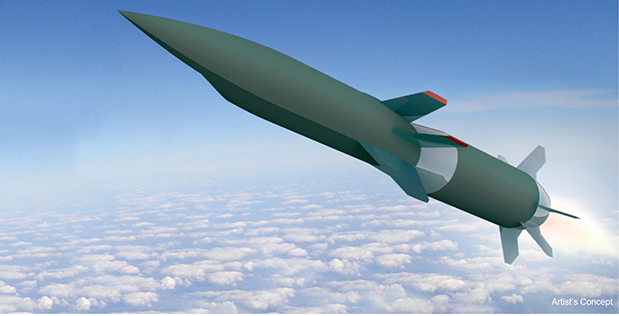
DARPA and the U.S. Air Force on Sept. 1 reaffirmed plans to start free-flight tests of two scramjet-powered missile demonstrators by the end of the year.
The Lockheed Martin and Raytheon variants of the Hypersonic Air-breathing Weapon Concept (HAWC) have completed captive-carry tests, a military official said.
The milestone events move the program closer to the first powered tests of a scramjet in flight since 2013, when the Boeing X-51A completed the last and most successful of four flight tests.
“These tests provide us a large measure of confidence—already well informed by years of simulation and wind tunnel work—that gives us faith the unique design path we embarked on will provide unmatched capability to U.S. forces,” said Andrew Knoedler, HAWC program manager in DARPA’s Tactical Technology Office.
The flight tests of both variants have been expected for several months. The original schedule for HAWC called for the first powered flight of the Lockheed version by the end of 2019, with Raytheon expected to follow close behind.
Lockheed completed a captive-carry test on a B-52H in May. The vehicle sustained damage during the test, but did not—as Aviation Week previously theorized—fall off the aircraft during the test. Despite the mishap, all of the objectives for the Lockheed captive-carry test in May were met, DARPA said.
DARPA has not released the timing of the Raytheon captive-carry test, but it likely was staged earlier this summer.
The X-51 proved that it was possible to fly near or at hypersonic speeds with hydrocarbon fuel, and the HAWC program intends to build on those results.
“Their upcoming flight tests will focus on hydrocarbon scramjet-powered propulsion and thermal management techniques to enable prolonged hypersonic cruise, in addition to affordable system designs and manufacturing approaches,” DARPA said in a news release.
The Air Force released plans in late April to launch a follow-on operational prototype of a scramjet-powered cruise missile. In August, the Lifecycle Management Center narrowed the bidding field to three teams: Boeing, Lockheed and Raytheon.
The future hypersonic cruise missile is expected to add a flexible new weapon to the Air Force’s hypersonic portfolio, which also includes the rocket-boosted glider program of the Lockheed AGM-183A Air-launched Rapid Response Weapon. The Air Force wants both weapons to be capable of launch from a bomber or a fighter.





